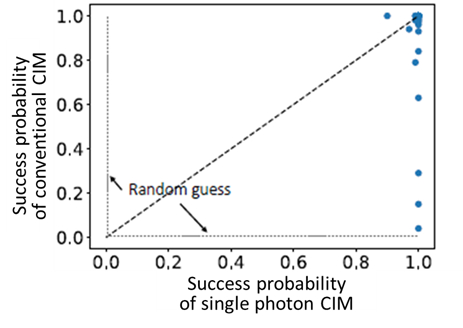NTT Research and Tohoku University Collaborate to Accelerate Development of Quantum Enhanced Coherent Ising Machines
News Highlights:
-
Researchers at the
NTT Research Physics and Informatics (PHI) Lab andTohoku University co-author paper outlining the capabilities of single photon Coherent Ising Machines (CIM). - Paper reports findings from a joint research initiative between the two organizations to bring to life large-scale cyber CIMs through high-performance computing.
- Single-photon CIM enables the conversion of fragile quantum entanglement into robust classical correlations between a measured pulse and all the other pulses.
This press release features multimedia. View the full release here: https://www.businesswire.com/news/home/20250709644790/en/

The success probabilities of the single photon and conventional CIMs are over 100 instances. The dashed line indicates the two success probabilities are equal. The success probabilities of the single photon CIM are superior to those of the conventional CIM with many photons per pulse.
Joint research agreement on large-scale cyber CIM with high-performance computing
Together, the two institutions are researching methods to bring to life a large-scale CIM simulation platform using conventional high-performance computing (HPC). This large-scale CIM will be critical to enabling cyber CIMs that will be widely accessible for solving hard NP, NP-complete and HP-hard problems.
The collaboration kicked off in 2023 with
“NTT Research’s collaboration with GSIS at
Critical to the JRA is the PHI Lab’s mission to use nonlinear quantum optical technologies to build simple, efficient and practical computing machines for real-world problems by redesigning analog/digital hybrid computers using the fundamental principles of quantum physics and neuroscience, drawing inspiration from biological computers present in brains. As part of this mission, the
A striking result
In contrast to the conventional and experimental coherent Ising machines (CIM) reported previously in Science 354, 603 (2016) and Science 354, 614 (2016), a newly proposed CIM employs an average photon number per pulse as small as one, which is eight orders of magnitude smaller than the photon number existing in the conventional CIMs. In such an extremely weak light limit, performance of CIMs must be evaluated through quantum theory rather than classical heuristic models.
The result of a numerical simulation based on the quantum model was unexpected, which is in sharp contrast to a standard picture. Initially, it was hypothesized that a CIM with a single photon per pulse suffers from poor signal-to-noise ratio in the measurement of internal pulse amplitudes and challenges to storing the analog amplitude information stably. Under this assumption, the performance is expected to be much worse than the conventional CIM with 108 photons per pulse.
However, the research team found that within a numerical simulation, the result is the complete opposite. The graph shows the probabilities of success for finding exact solutions for various instances by single photon CIM and conventional CIM with 108 photons per pulse. The figure indicates the performance of the single photon CIM is much better than that of a conventional CIM.
Quantum enhancement mechanism
The superior performance of the single photon CIM discovered by the collaboration originates from a quantum mechanical effect. At a measurement port of the CIM, an extraction beam splitter generates a correlated internal pulse and extracted pulse to be measured, that is, the amplitude of the extracted pulse carries an information of the internal pulse amplitude. This correlation between the internal and extracted pulses penetrates into a quantum regime in spite of background noise which indicates the existence of quantum entanglement between these two pulses in the single photon CIM.
Despite the fragile nature of a quantum entanglement that can be easily destroyed by optical loss and background noise, the single photon CIM was able to convert the fragile quantum entanglement into robust classical correlations between a measured pulse and all the other pulses through its quantum measurement and feedback process. The generation of quantum entanglement and its immediate conversion to classical correlation is key for understanding the improved performance of the single photon CIM, which is absent in conventional CIMs that leverage many photons per pulse.
Looking ahead,
About
The names
View source version on businesswire.com: https://www.businesswire.com/news/home/20250709644790/en/
NTT Research Contact:
Chief Marketing Officer
+1-312-888-5412
chris.shaw@ntt-research.com
Media Contact:
For
+1-804-500-6660
ngibiser@wireside.com
Source:
